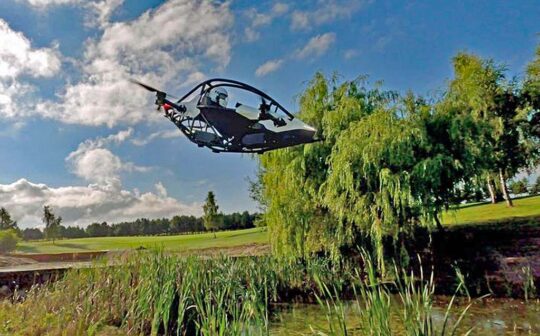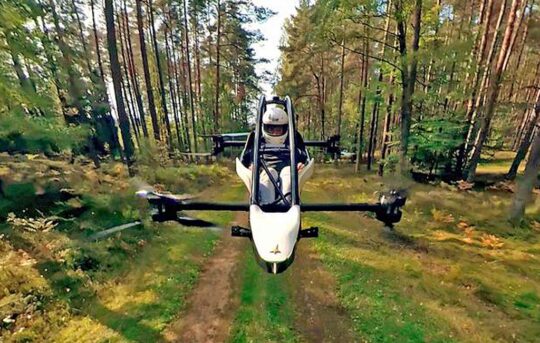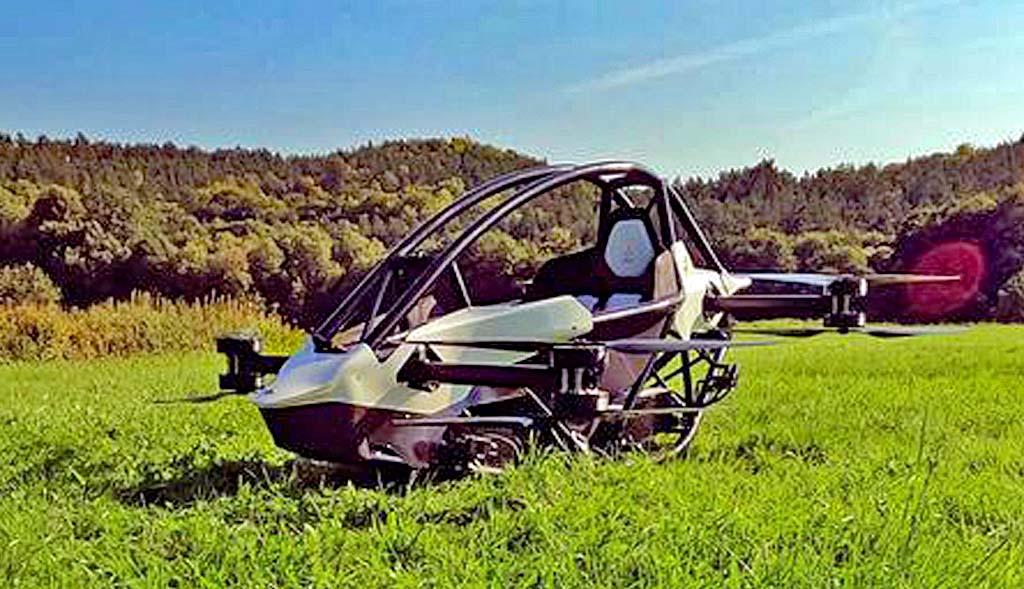
Now, as anyone who has not been vacationing on Mars the last couple months probably knows, another new multicopter is captivating YouTube gazers.
Dubbed Jetson One after the famous TV cartoon from decades past, this small vehicle is certainly intriguing… even if you are one of many current-day pilots who dismiss these aircraft. The video below has been viewed more than 14 million times in three months!
Not only haven’t we seen the last of this, more likely this is just the beginning.
No, Not Air Taxis…
Recreational Multicopters
Look, this article is not about air taxis or so-called UAM vehicles (Urban Air Mobility, according to some who enjoy making up new names for these multi-motored flying contraptions). Uber Air may be coming but I’ll bet it is years in the future because of new regulations that will be demanded by the political class and concern from the big-city general public about weird aerial machines buzzing overhead.

Indeed, people who might buy one of these aircraft could conceivably outnumber all current-day pilots. So, as my clickbait title asks, “Are we Sport Pilots an endangered species?”
“We aim to make the skies available for everyone with our safe personal electric aerial vehicle,” writes the producer. “We intend to make everyone a pilot.” Are you good with that? Millions of new pilots? You could be the minority. Or maybe not. Future history cannot be written yet.
What is Jetson One?


Developers Peter Ternstrom and Tomasz Patan tower over their small vehicle, which can be folded to take up very little space.
The chassis, as the company calls it, is constructed of aluminum with carbon fiber for the balance of the structure.
“The aircraft is being produced under FAA Part 103 rules and, as such, owners do not need a pilot’s license to fly it,” wrote FutureFlight.aero accurately and assuming it can address an FAA challenge). “Jetson says it provides a day of flight training to customers, who complete assembly of the $92,000 aircraft themselves.” To place an order, the company asks for “a deposit of $22,000.”

“We aim to make the skies available for everyone with our safe personal electric aerial vehicle,” say the two developers. “Jetson One [is] a commercially available personal electric aerial vehicle that you can own and fly.”
Jetson One
TECHNICAL SPECIFICATIONS
- Jetson empty weight — 190 pounds (86 kilograms)
- Maximum pilot weight — 210 pounds (95 kilograms)
- Dimensions — 8 feet long x 5 feet wide x 3 feet 4 inches tall (2,480 mm x 1,500 mm x 1,030 mm)
- Width when folded — 3 feet (900 milimeters)
- Flight duration — 20 minutes
- Top level flight speed, software limited — 55 knots / 63 miles per hour (102 kilometers per hour)
- Service Ceiling — above 1,500 feet AGL
- Flight controls — 3-axis joystick / throttle lever
- Battery type — high discharge Lithium-Ion
- Charging time — 1 hour on 220 volts / 2 hours on 110 volts
- Max total power output — 118 horsepower (88 kilowatts)
- Chassis type — all-aluminium space airframe
- Motor type — high power output electric brushless outrunner

Previously, I’ve written about a “motorcycle” multicopter called Scorpion — the Opener Blackfly (with its own unique approach) — the Kitty Hawk Flyer (since withdrawn from the market) — and most recently, the Lift Aircraft Hexa, which is taking a different tack than others with a plan to rent their aircraft. All these entries asked to qualify under Part 103.
I have also written about many other multicopters on this website but several have already disappeared. Even earlier concepts, so-called roadable aircraft or flying cars, seemed to have lost inertia. Recently, pioneering developer Terra Fugia reported they are putting their Transition on the back burner while they change focus.
We cannot know what tomorrow holds. Reports of the demise of “conventional” aviation may be premature. Yet videos like the one below draw large numbers of views. At least it shows an interest in flying.


The comments cover the spectrum of opinion……and range from amusing to “it must be a bureaucrat.” In today’s world sarcasm, simile and metaphor are rapidly going the way of the long term future of liquid carbon storage? I know, kerosene is still around after thousands of years. Never say never…electric technology applications will abound…as soon as we figure out that pesky necessity of energy storage that doesn’t weigh a ton. (its a hyperbole folks…no drag coefficient analysis required). :-))
Dan, I believe around half of those million pilots are in the US based on AOPA statistics. And what we have going for us is the US military, the US Air Force in particular encourages flying without doing it publicly. Because they need a large pilot pool if a war ever starts. And this thinking reverberates back into the executive and legislative branches of government as part of survival. So little chance exists of any aircraft segment being endangered; with so much hidden support; by necessity as seen by these sources. The FAAs job is also to promote aviation; though it is always in the background for them because safety is first. So no concern should exist for any segment of aviation having any endangered thoughts. Pilots, are the survival of the human race; in numerous ways; if you take government seriously. The government can not live without pilots and their aircraft. Government survival depends on pilots and their aircraft. They know it; but will never admit to it. They do not need to and are satisfied with aircraft and pilot development as it is occurring. And any kind of back up on flying or aviation would be seen as counter productive to government safety by government. Though, almost no one will admit to it. So, please no more use of the word “endangered” with pilots or aircraft. It is a non sequitur word in our civilization. Perpetual aircraft and pilot expansion and growth is the necessity of government. Or pilots and aircraft are as safe as it gets because government survival is always in the background.
I agree with your assessment of the pilot population residing about half in the United States and half in the entire rest of the world combined, with Europe being the strongest next region.
With regard to government and their support of aviation. I imagine you might agree that the support of government is not always what it’s cracked up to be. However, I think you make a valid point that militarily and for transport, it’ll be a long time before autonomous aircraft are hauling important people around (meaning, of course, that no pilot is on board). I will note that my direct experience, significantly with the personnel of the aircraft certification branch of FAA, has shown that many or most of these people truly do want recreational aviation to prosper. We don’t always like their rules, but it doesn’t make them bad people.
My use of the word “endangered“ was clearly a clickbait-type title. I wanted to get the attention of folks to consider the impact of multicopter/eVTOL products coming into the airspace. My standard line about advancing technology is that when we get to that “Beam me up, Scotty“ future, the airlines will be dead but recreational aviation will thrive.
Thanks for the response. Except the Beam me up, Scotty is not in our future; is pure fiction. The only exception I know are Chinese researchers have been able to create the dual action effect of quantum physics from their location to an orbital location 500 or so miles up. But has only been done on a quantum level. Not anything larger. Suggesting it is not possible to do quantum physics on a large scale or beaming up anything that lives or anything on the scale size of a human. And in flying; avoiding fiction is essential as you know based on the extensiveness of aviation regulations. I can not picture the airlines ever being dead. Even as a pilot, taking the airlines can be preferable to all the details of insuring a safe flight yourself. Which I know you know is substantial. Letting the airline pilots do the checklists insuring and airworthy flight; keeping track of fuel, weather, and other aircraft is just fine with me. I am well satisfied to pay the airlines for all of this hidden value. So your future view of aviation does not work for me. The Airlines will always be around as the easiest way to travel! The recreational aircraft market can only continue to grow because more and more people will want; maybe even need; this alternative.
You saw the trees but missed the forest. “Beam me up Scotty” is just a metaphor. I’m sure the airlines aren’t going away anytime soon.
Thanks for the clarification; but I do not think so. Metaphors with real products is trouble. Only facts with real products keeps people on the reality track of what is really going on. But, I appreciate the interaction.
Each iteration of this type of vehicle is become more refined and more capable. The specs are impressive (210 pound pilot) and 20 minute time flight duration out of a vehicle that folds up to be no larger than a snowmobile.
20 years ago soaring pilots laughed at electric propulsion in self-launch gliders and gliders with sustainer motors. Now almost 50% of the new gliders being sold are self-launch and a majority of those are electric with the glider sustainer market being mostly electric.
Will be interesting to see where these air vehicles will be at in 10 years (price, kits along with specs).
TY
Tim
It’s pretty cool looking I might be interested if it had a longer range.
Seems to me, huge potential for human lawn darts no matter how robust the software. How easy is it to get hacked?
I can see FAR part 103 getting revised significantly in the future because of vehicles like this. At the least pilot certification requirements specific to this type of vehicle.
As an autonomous evtol aircraft; it is probably not possible to hack its software. Hackers would need access to this evtol aircraft to hack that individual evtol. Or, assuming something this light and small would have access to the internet would be very foolish; where hacking does occur. FAR part 103 is near sacrosanct; meaning no one is going to change it during our life time; if you believe By Dan Johnson and the FAA. Your comments do not match the history of software or Part 103. I assume you are new to this location … based on past history and where events will likely go in the future based on that past history. Or are you just not trained in either of these fields: Software or Part 103? Strongly suggesting that you get some training and/or do some extensive reading. All the best, in any case.
Paul
I can understand your software issue. But do you realize that all modern military and large commercial jets (passenger and cargo) are all software controlled. The computers fly the aircraft and the flight control systems are up to quad redundant. The Jetson has 8 motors/controls and a number of redundant computers and sensors. Your robust point is a concern as one relies on the designers to have programmed for every what if. Designers are not perfect (look at airbus AOA sensor failure and the 737 max), but most of the time they are pretty close as there are many dozens of aircraft types that have been flying by wire for the last 3 decades.
Your point about Part 103 may be valid, but it is going to be many years before these vehicles start to become an issue for the FAA simply because their expense will limit the numbers. Personally, I don’t see why a “pilot certification” is needed as these are basically ground level vehicles and more of an ATV than an aircraft based on the stated 1500 feet maximum altitude. Traditional ultralights can and do fly much higher and the FAA hasn’t made any changes to Part 103.
Tim, pilot certification with sport pilot privileges matches your statement “ground level vehicles are more of an ATV than an aircraft”. And the fact that part 103 aircraft do not need an N number shows how far the FAA has changed. It is never smart and usually highly erroneous to compare any large or commercial aircraft to small aircraft because the latitude of taking one’s life into one’s hands has substantially more freedom than any commercial aircraft operator. Or simply small aircraft vs large or commercial aircraft are two different worlds; generally not comparable. Software will be an on going tricky subject because it is so complex. Except it is fair to say as you have pointed out; the software designers will be on the hot seat to insure they have included a software response for any flight attitude or any flight condition. The Opener software engineers have been giving me pause because no one will say no to a ballistic parachute and training the novices to glide the Opener BlackFly; as everyone is trained to do in other aircraft; at least at every BFR.
I think the Jetson is neat. And while these ‘things’ are still novelty items at this point (the cost and 20-minute flight time alone just scream “toy for wealthy people!”), at some juncture in the next 10 years we could start seeing these sold en masse.
At that point there will almost certainly be implications for Part 103. Whether those implications are good or bad, well…I don’t have that crystal ball. Perhaps my biggest worry is that these types of aircraft will be purchased primarily by people who aren’t really “pilots”, and some of those people will start doing stupid things…like flying in controlled airspace, flying in places or circumstances that endanger other people, or otherwise doing things that just give light aviation a really poor reputation and look. If that were to happen, the public might overreact (as they tend to do) and the FAA could say “We really have to reform this whole Part 103 thing. The barriers to entry are too easy!” That’s probably my biggest worry.
Otherwise, yeah…you have to admit this new technology is pretty cool!
You make several good points, Steve. However, some parts of your concern can be addressed by the software, which could limit where these things could be flown even by someone who disregards common sense and accepted rules of the air. Yet as I have repeated many times, all that is possible only when the software is sufficiently robust. It may be there now; I just don’t know that for sure.
Great point. Location limiting software is currently installed on $250 drones so it seems it is currently fully developed.
Pilots need to be able to fly anywhere to see and avoid other aircraft. So location limiting software can never occur in piloted aircraft. Class E & G airspace is 98% of all US airspace where see and avoid is the rule of the air. Drones will always be limited not having a pilot or person on board. And you can not make comparisons of piloted aircraft to drones because the rules are substantially different. Life; pilot and passengers, are given paramount value over property in airspace rules. You really need some pilot training to actually understand not only US airspace, but all airspace on planet Earth. It starts with a sectional chart for your location and a terminal control area (TCA) chart if you are in a metro area to know where classes E & G airspace are located; see and avoid only. Somewhere I thought all drone pilots were supposed to use sectional charts and TCA charts for their flying; and to know the nuances of see and avoid. By default; you appear to not know of these charts; which probably puts you in trouble with the FAA. Get the charts mentioned so you know where you can fly!!! Of course designated locations for drones and RC model aircraft negates the need for charts; which I assume is how you fly your drone legally.
Terry;
Clearly you are an expert pilot and probably have lots of ratings and thousands of hours, but you seem to be making a lot of assumptions about what it takes to be a “pilot.” Part 103 states the flight rules, requirements, restrictions etc, but has no “Pilot training” requirements. Part 107 is a different story as one has to pass a 60-question test that does include questions relating to airspace and section charts, but there is no requirement for a Drone pilot to have or use a sectional chart.
Al’s point is a very interesting one in that the Jetson One could use the “Fencing” software concept to warn and ensure a Jetson One cannot take off in a “fenced” area and if airborne the software could bring the Jetson One to a stop (hover) before it enters the area.
Your point about limiting software is interesting as fly by wire aircraft software have lots of limits built into the software. First example I thought of was stall (try to stall an F/A-18). Second example was g loading limitations (try to overstress a 787). Third example is CG and weight limitations (A380 limits Gs based on weight and loading). All fly by wire aircraft have programmed flight envelope limitations as the computers can only fly the bird up to the edges of the defined envelope.
As far as Steve’s point about people doing stupid things, I’ve known of a few multi-thousand-hour pilots that have done things, including a US military test pilot that I would not fly with. The key is that under Part 103 weight, speed, fuel limits, and Hazardous operations rules the stupid stunts shouldn’t get anyone on the ground killed.
Respectfully;
Tim
Tim, I have never ever claimed to be an expert. But have done my share of flying and training. What you appear to be ignoring, is any applicable FAR is operative; meaning parts 61 and 91 are operative for all pilots; though part 61 has been superseded by sport pilot rules. But part 91 like part 103 will always be a part of small aircraft flying; basic flight rules are located at part 91. Anyone flying outside of a designated location on a sectional chart or a terminal control area chart should have one of these charts in their possession in case they have a collision that brings out the police or the FAA or both. No need to take my word for this; talk to any flight instructor or any FAA person. Comparing military or commercial aircraft to small aircraft; I am sorry; is silly; no reality in that at all. Rules in the 200 or so class B; C; and D airports have nearly no relation to what goes on at class E airports. Except where previous precedent or an emergency occurs; military and commercial aircraft do not land at class E airport locations. We all do stupid things from time to time; there is no limit in this respect. The difference; as a trained pilot as with all pilots; when flying I go to my highest level of alertness; as do all pilots; to avoid any anomaly that could endanger the flight. It is part of pilot training. Or while flying; reality is front and center for all pilots; along with alertness. Software in small aircraft will always be secondary; though likely a necessity most of the time. In small aircraft, the pilot in command makes all the flight decisions; software will never have the final say in small aircraft. The FARs are written for the pilot in command and the FAA will not change this. You can take this to the bank.
Terry:
I tend to agree with your points, but the FAA does not. Please look at Part 61. Part 61 does not cover “The person” operating an “Ultralight Vehicle”. Please note the quotations as those words are used throughout Part 103. Pilot and aircraft are not used in Part 103 for specific legal reasons. One being the FAA has removed themselves for the management requirements for vehicles and the operators of those vehicles meeting the requirements of 103. Part 103 is intended to stand alone from the rest of the FARs. This doesn’t mean the Person operating the ultralight vehicle can be ignorant of “basic” Part 91 rules. Of course what is “basic”? It would clearly be a subset of rules than a Sport Pilot should know. It would be nice if the AIM included a breakout for Part 103 and Part 107 like it does for the Part 61 listed pilot.
Your point about “the pilot is command makes all flight decisions” is correct and as old school as the aircraft we learned to fly in. The Jetson One is an “ultralight vehicle” and appears to be not only implementing state of the art fly-by-wire in an ultralight, but it is also pushing the state of the art to a new level for small aircraft. The state of the art is moving forward fast. My new car does automatic braking if it detects a potential collision, which sure surprised me the first time the auto-braking occurred. The point is that technology is implementing automated anti-collision systems in cars and that type of technology will become available in future small aircraft, drones and ultralight vehicles.
Your point about the sectional chart is almost correct. When I fly SEL or motorglider I have electronic sectional in my iPad Mini (I’m legal). When I fly in my glider I only carry my cell phone as I can access everything I need in real-time including a sectional chart by calling up a local airport’s information and sectionals (again I’m legal). The electronic age has changed the actual requirement to have a paper chart in one’s possession. The FAA does make modernization changes to keep up with technology.
But back to your main points, the Part 103 operators needs to meet, understand and operate with the requirements laid out in that section. They need to study or get training to gain and understand the knowledge to safely operate their ultralight vehicle. But they are not required to have the knowledge level of a Sport or Private pilot. So we pilots have to be acceptive of those that operate ultralights and if they are not doing something correctly, be patient and take the time to nicely explain the rules in a way they can understand them. That means, not quoting Part 91! It means describing and explaining the area of Part 91 as it applies to the situation and helping them learn.
Respectfully
Tim
Tim, Thanks. I agree with you except for two items; one of which I previously mentioned: part 61 has been superseded by sport pilot rules. The other: part 91 must be followed by all pilots. So you are not correct in saying a sport pilot does not have to have the knowledge of a private pilot. All pilots must know in detail and the nuances of FAA part 91 flight rules. There are no exceptions to this. Which means using aircraft charts and filing flight plans if going from point A to point B. The difference between a sport pilot and a private pilot is the aircraft flown only. All the best. If anything else should come up, email me at: tdwelander@gmail.com
Dan. This entire discussion is a fairy tale unless and until you research and address. INSURANCE. As with current Light Sport offerings, the aviation insurers totally control who can buy and fly these new unique aircraft.
Forget any FAA issues. The insurance underwriters are our challenge.
You will get no argument from me. I have long said FAA thinks they regulate and control aviation, but truly it is the insurance companies for nearly all buyers.
You will probably not get any argument from any pilot. The insurance underwriters cross their Ts and dot their Is better than any government agency; and drive pilots nuts with their erroneous details. If anyone is responsible for retarding aviation; it is the insurance underwriters. Though I have never met anyone who has thrown up their hands at the insurance underwriters. Though many of us have thought of it. Fortunately, numerous choices exist with insurance underwriters. Meaning, if one is too erroneously detailed; another is available somewhere. I have contacted all of the insurance underwriters I know for insurance on an Opener Blackfly. None are currently insuring the Blackfly; to my dismay. My assumption is Opener will need to supply an insurance underwriter; but has not said so; if they expect anyone to make a Blackfly purchase. Endless details on flying keep flying safer than driving; probably up to three times safer than driving based on NTSB statistics. Making me happy to be a pilot; even with the above listed distraction.
As an avid follower of the Opener Blackfly, I have made numerous posts on the Opener linkedin website; accessible at the last FAQ at the Opener website on flying in class E & G airspace; 98% of all US airspace for evtols. The Opener Blackfly has already won this competition in my mind and probably most peoples minds because it is a biplane. One needs those wings for lift; not just propellers; and to minimize power consumption for cross country flight letting the wings provide the lift. No other evtol currently uses wings; Opener has a patent on evtol wings I believe. Class A airspace is above 18,000 feet MSL and not where any evtol will ever be located. Leaving airspace classes B; C; and D; control tower airports where radio communication and a transponder are needed. But at less than 2% of all US airspace, there should never be a need for an evtol to be in airspaces classes B; C; or D; where instrument flight and airliners are located. No reasonable person wants to mix with airliners or bad weather. I believe all evtol manufacturers will require all their evtol purchasers to demonstrate knowledge of aircraft sectional charts and terminal control area (TCA) charts in order to stay out of airspace classes B; C; and D. Or your concerns do not match reality as I know it. The fact that you mentioned this potential problem shows you are a thinking pilot and should die of old age rather than something in the air.
Also need to mention TFRs, MOAs, and Restricted Areas, as shown on charts.
Is the Risen sold in the U.S.?
If by Experimental only, how much would a kit sell for?
I’m not sure why you ask this question in this article, but here’s link to the producer.
The company has made at least one sale to the U.S., but you should ask the company directly for more detail.
Risen is not going to be an inexpensive purchase.
My interest is way beyond a volcano. This forward thinking is so out of the box and unbelivable.